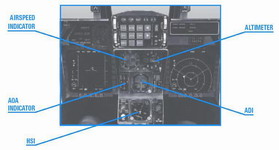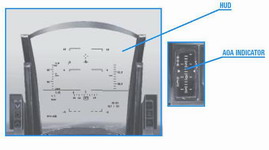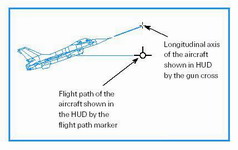
Cockpit From "Kofana"...
We should discuss a number of cockpit instruments and displays before getting airborne. Make sure you are in the 2-D
Cockpit view.
The ADI (Attitude Director Indicator) provides an artificial horizon and an aircraft symbol so you
can tell the attitude or orientation of the aircraft relative to the earth.

The airspeed indicator shows the aircraft's airspeed in hundreds of knots. When the red needle
is on the "4," you are going 400 knots. The altimeter shows the MSL altitude (altitude above sea level) of
the aircraft on the round dial. The digital readout on the inside of the dial shows the altitude in thousands
of feet. The white needle on the dial displays the altitude in hundreds of feet.

The AOA indicator is a tape that shows the angle of attack of the aircraft. In order to generate lift,
the jet needs to have a positive angle of attack or fly at a positive angle into the relative wind
(airflow). The F-16 has a 25 degree positive and 5 degree negative AOA limit. Remember that the AOA is
the angular difference between the gun cross and the flight path marker.
The HSI (Horizontal Situation Indicator) is a very complex gauge we will cover in Training Mission
12. For now, all you need to know about the HSI is that it can be used to indicate aircraft
heading. The round moving dial on the HSI shows N/S/E/W for north, south, east and west.
When the aircraft turns, the dial moves to indicate the change in aircraft heading.

The RPM gauge shows the revolutions per minute of the turbine blades at the core of the engine.
RPM is shown as a percentage, with 100 % being the fastest the engine can go and 0% being
an engine that is not turning at all. 70 % is idle power. RPM is directly tied to throttle position,
which controls how much thrust the engine produces.






